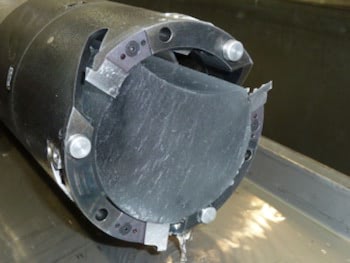- Undergraduate
Bachelor's Degrees
Bachelor of ArtsBachelor of EngineeringDual-Degree ProgramUndergraduate AdmissionsUndergraduate Experience
- Graduate
Graduate Experience
- Research
- Entrepreneurship
- Community
- About
-
Search
All Thayer News
Innovations in Ice Drilling Enable Abrupt Climate Change Discoveries
Dec 17, 2012 | by Mary Albert | IDPO
A revolutionary drilling system leads to the retrieval of additional ice for evidence of abrupt climate change from the Antarctic Ice Sheet.
Deep within ice sheets in the Polar Regions is an archive of evidence about the climate of the past. Ice cores drilled in the past have yielded amazing scientific discoveries, for example that climate can change abruptly in less than ten years, and that the CO2 in the atmosphere now is higher than evidence from the last 800,000 years. At the WAIS Divide site, a cold area of the West Antarctic Ice Sheet where the abundant snowfall rarely melts, the ice contains many tens of thousands of years of annual information about past climate. At specific depths in the ice sheet, including from times of abrupt climate change in the past, scientists are investigating past greenhouse gas records and other evidence from the ice that will help to understand why and how abrupt changes occur.
 The first meter of replicate ice from 3001 meters depth in the WAIS Divide Ice Core borehole in West Antarctica. Credit: Jay Johnson, University of Wisconsin-Madison.
The first meter of replicate ice from 3001 meters depth in the WAIS Divide Ice Core borehole in West Antarctica. Credit: Jay Johnson, University of Wisconsin-Madison.
Now, for the first time, significant innovations in drilling engineering are providing scientists and engineers with replicate ice cores from targeted depths and directions in the ice sheet. The newly developed, state-of-the-art Replicate Coring System is capable of retrieving additional ice cores from specific depths on the uphill side of the main borehole. Engineering that addresses priority science needs for ice coring and drilling is provided by the National Science Foundation (NSF) through an agreement with the Ice Drilling Program Office (IDPO) led by Dartmouth Professor of Engineering Mary Albert, in collaboration with the University of New Hampshire and the Ice Drilling Design and Operations (IDDO) drilling group at the University of Wisconsin.
The Replicate Coring technique, developed and tested by the IDDO engineers as part of the DISC Drill, is now producing the first-ever replicate ice cores from a nearly vertical main ice borehole. The design of the DISC Drill was started by the Wisconsin group in 2002 in response to the desire of the US science community for a deep coring drill that would incorporate the ability to retrieve additional cores from deviations from the main borehole. The DISC Drill was put into service at WAIS Divide during the 2007-08 Antarctic field season and completed the main borehole during 2011- 12 reaching a depth of 3,405 meters. Testing of the replicate coring system began at the end of the 2011-12 season.
Link to source:
http://www.icedrill.org/news/press-release_2012-Dec-17.shtml
For contacts and other media information visit our Media Resources page.
